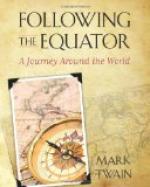There are three or four other celebrated craters near by a circle three miles in diameter would enclose them all. They are owned by the De Beers Company, a consolidation of diamond properties arranged by Mr. Rhodes twelve or fourteen years ago. The De Beers owns other craters; they are under the grass, but the De Beers knows where they are, and will open them some day, if the market should require it.
Originally, the diamond deposits were the property of the Orange Free State; but a judicious “rectification” of the boundary line shifted them over into the British territory of Cape Colony. A high official of the Free State told me that the sum of $4,00,000 was handed to his commonwealth as a compromise, or indemnity, or something of the sort, and that he thought his commonwealth did wisely to take the money and keep out of a dispute, since the power was all on the one side and the weakness all on the other. The De Beers Company dig out $400,000 worth of diamonds per week, now. The Cape got the territory, but no profit; for Mr. Rhodes and the Rothschilds and the other De Beers people own the mines, and they pay no taxes.
In our day the mines are worked upon scientific principles, under the guidance of the ablest mining-engineering talent procurable in America. There are elaborate works for reducing the blue rock and passing it through one process after another until every diamond it contains has been hunted down and secured. I watched the “concentrators” at work big tanks containing mud and water and invisible diamonds—and was told that each could stir and churn and properly treat 300 car-loads of mud per day 1,600 pounds to the car-load—and reduce it to 3 car-loads of slush. I saw the 3 carloads of slush taken to the “pulsators” and there reduced to quarter of a load of nice clean dark-colored sand. Then I followed it to the sorting tables and saw the men deftly and swiftly spread it out and brush it about and seize the diamonds as they showed up. I assisted, and once I found a diamond half as large as an almond. It is an exciting kind of fishing, and you feel a fine thrill of pleasure every time you detect the glow of one of those limpid pebbles through the veil of dark sand. I would like to spend my Saturday holidays in that charming sport every now and then. Of course there are disappointments. Sometimes you find a diamond which is not a diamond; it is only a quartz crystal or some such worthless thing. The expert can generally distinguish it from the precious stone which it is counterfeiting; but if he is in doubt he lays it on a flatiron and hits it with a sledgehammer. If it is a diamond it holds its own; if it is anything else, it is reduced to powder. I liked that experiment very much, and did not tire of repetitions of it. It was full of enjoyable apprehensions, unmarred by any personal sense of risk. The De Beers concern treats 8;000 carloads —about 6,000 tons—of blue rock per day, and the result is three pounds of diamonds. Value, uncut, $50,000 to $70,000. After cutting, they will weigh considerably less than a pound, but will be worth four or five times as much as they were before.




